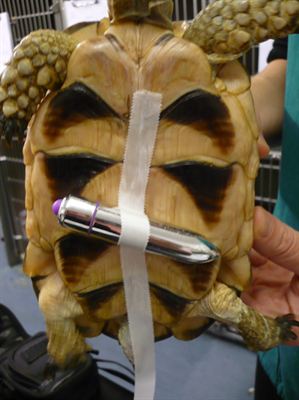Vibrating tortoise is ‘cured’ as experts warn that tortoises are NOT easy pets

A sick tortoise, which had been kept in a glass tank and had become severely constipated having eaten the gravel and stones on its cage floor, has recovered after an ‘adult sexual aid toy’ was used as a vibrating massager strapped to the underside of its shell. On arrival at the vets in Barons Court, London, the poorly tortoise was very weak and its head was withdrawn, probably due to pain. However, after a twice-a-day treatment for several weeks with the vibrator, the tortoise came out of its shell and is now strong and healthy. This novel treatment has been published by the Journal of Herpetological Medicine and Surgery*, and is now also being used to help other animals such as constipated dogs.
Captive tortoises have been known to eat the substrate of their enclosure through hunger, thirst, disease, lack of stimulating environments or accidentally with their food. Some substrates marketed for pet tortoises are unsuitable. In this case, the tortoise had eaten around 120 stones, and some gravel pieces found in the tortoise’s droppings measured more than 1cm in diameter – creating a potentially fatal impaction in the animal’s gut.
Many pet shops advise that tortoises can be conveniently kept in glass tanks (or vivariums). The Animal Protection Agency (APA) believes keeping tortoises in vivariums is inhumane. Indeed, the authors of the new article recommend “spacious, naturalistic environments that can probably only be achieved in specifically designed and managed ‘tortoise paddocks’ and outside ranges.”
The APA, which campaigns against the trade in wild animals as pets, including reptiles such as tortoises, maintains that tortoises are not suitable pets. A recent scientific article found that at least 75% of pet reptiles die within their first year in the home. ** The complex care needs of tortoises vary from species to species – for instance a tropical tortoise can have very different dietary, temperature, humidity and housing requirements to a Mediterranean species. Despite this, the exotic pet trade continues to market reptiles as ‘easy to keep’.
Say authors of the paper:
Emma Nicholas MA VetMB MRCVS, Veterinary Surgeon:
“The team at Barons Court Vets spent many weeks treating this tortoise twice daily until he was fully recovered. I hope this case helps to demonstrate how difficult it can be to keep tortoises as pets and notice early the signs of illness or stress. Whilst vets must do their utmost to treat these animals and educate their owners, where necessary, in matters of husbandry, I believe it important that we do not encourage the ownership of such pets.”
Clifford Warwick DipMedSci CBiol FSB, Reptile Biologist:
“Tortoises, like other reptiles, are often mis-sold as ‘easy’ or ‘suitable’ pets, and many people simply do not understand what they are getting into. In my view, marketing tortoises and vivariums together is an especially bad idea, which almost cost this animal its life. I cannot help but wonder how many other tortoises have suffered and died in similar situations.”
Notes to Editors
- * Nicholas, E. and Warwick, C. (2011) Alleviation of a gastrointestinal tract impaction in a tortoise using an improvised vibrating massager, Journal of Herpetological Medicine and Surgery. Volume 21, Issue 4. * (Although dated 2011, this latest issue was published last week as the journal is a year behind schedule).
- ** Toland, E., Warwick, C. and Arena, P.C. (2012) Pet Hate, The Biologist. Volume 59, Issue 3.
- For further information or images, please contact Elaine Toland on 01273 674253 or out of hours on 07986 535024. We have an ISDN line for broadcast-quality interviews.
Animal Protection Agency
Brighton Media Centre, 15-17 Middle Street, Brighton BN1 1AL
Tel: 01273 674253
info@apa.org.uk
www.apa.org.uk
Tags:

